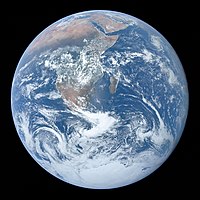
Photo from wikipedia
Abstract. The continental tropics play a leading role in the terrestrial water and carbon cycles. Land–atmosphere interactions are integral in the regulation of surface energy, water and carbon fluxes across… Click to show full abstract
Abstract. The continental tropics play a leading role in the terrestrial water and carbon cycles. Land–atmosphere interactions are integral in the regulation of surface energy, water and carbon fluxes across multiple spatial and temporal scales over tropical continents. We review here some of the important characteristics of tropical continental climates and how land–atmosphere interactions regulate them. Along with a wide range of climates, the tropics manifest a diverse array of land–atmosphere interactions. Broadly speaking, in tropical rainforests, light and energy are typically more limiting than precipitation and water supply for photosynthesis and evapotranspiration; whereas in savanna and semi-arid regions water is the critical regulator of surface fluxes and land–atmosphere interactions. We discuss the impact of the land surface, how it affects shallow clouds and how these clouds can feedback to the surface by modulating surface radiation. Some results from recent research suggest that shallow clouds may be especially critical to land–atmosphere interactions as these regulate the energy budget and moisture transport to the lower troposphere, which in turn affects deep convection. On the other hand, the impact of land surface conditions on deep convection appear to occur over larger, non-local, scales and might be critically affected by transitional regions between the climatologically dry and wet tropics.
Journal Title: Hydrology and Earth System Sciences Discussions
Year Published: 2019
Link to full text (if available)
Share on Social Media: Sign Up to like & get
recommendations!